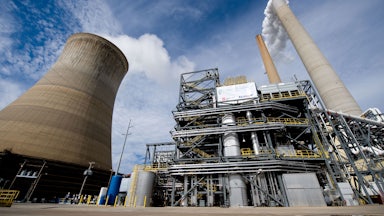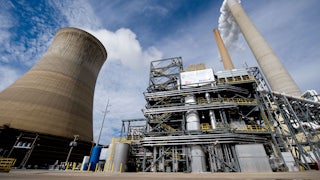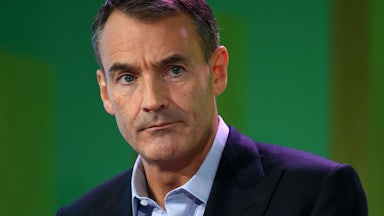The window to confront climate change is quickly narrowing. A new report released last week by the Intergovernmental Panel on Climate Change, or IPCC, makes this painfully clear.
The report is also reinvigorating a long-standing debate around what sort of role technologies that remove carbon from the atmosphere should have in confronting the climate crisis. Climate advocates are being offered a false choice between giving in to corporate carbon removal, driven by profits and greenwashing, or fighting it. But there’s an entirely different option: The United States and other rich countries could instead pursue equitable development and scale-up of carbon removal technologies under a public model of ownership and governance.
Climate organizers, policy activists, and scientists have been sharply divided on carbon removal, which refers to a wide range of approaches at varying stages of scientific knowledge and technical maturity, from farming in ways that store more carbon in soils to machines that capture carbon directly from the atmosphere. One camp believes carbon removal is necessary for confronting climate change. Another camp believes that the feasibility of large-scale carbon removal remains hypothetical and that the prospect of this approach, in the meantime, will serve as a handout to fossil fuel companies and a license for emitters to continue business as usual, distracting us from the need to reduce emissions immediately.
As evidence, opponents of carbon removal point to investments by oil companies in industrial carbon removal approaches; they cite the many corporate net-zero plans that rely on buying large amounts of carbon removal. With increasing demand from large emitters like Microsoft, dozens of new carbon removal startups are launched every year, often funded and controlled by fossil fuel companies. The federal government just committed $3.5 billion to building four hubs for industrial carbon removal, without limitations on that funding flowing to private corporations.
So the carbon removal industry is getting attention, but is that warranted? In its new report, the IPCC is clear on the question of whether these practices and technologies are needed: “The deployment of carbon removal to counterbalance hard-to-abate residual emissions is unavoidable if net zero [carbon dioxide] or [greenhouse gas] emissions are to be achieved.”
The need for carbon removal isn’t just an artifact of modeling, though some economic modeling scenarios have been overly reliant on carbon removal. Citing high outliers from these model outputs, journalistic pieces, carbon removal investors, and even expert reviews have breathlessly called for 10 to 20 billion tonnes of removal per year by the end of the century—astronomical quantities, equivalent to 25–50 percent of current global carbon dioxide emissions—without more deeply evaluating these claims. But this tendency has been critiqued for several years now, first by scientists skeptical of the overall scale and reliance on natural solutions, such as reforestation and coupling bioenergy, to carbon capture and later by activists worried about the overstated need for carbon removal being misused by fossil fuel companies. Other scientists then responded to this critique, producing modeling studies that instead focused on reducing fossil fuel use. The newest IPCC report examines these demand-side reductions in great detail, which is progress.
/ In honor of Earth Day, Apocalypse Soon content is free to registered users until April 29. Start reading now.
What a lot of commentary misses is that even in ambitious climate action scenarios, where carbon removal is downgraded and the energy sector goes fully renewable, carbon removal is still necessary to compensate for other greenhouse gas emissions, largely from agriculture, and a small amount of carbon dioxide. Limiting warming to anything close to 1.5 degrees Celsius (2.7 degrees Fahrenheit) hinges on being able to do some atmospheric carbon removal—perhaps on the order of 1.5 to 3.1 billion tonnes of removal per year, to compensate for emissions that are extremely difficult to eliminate. (To be sure, these numbers are still very large: One billion tonnes of annual removal would take 10 percent of the world’s current electricity generation to power an industrial removal process, or require growing a forest the size of Texas.) It could also be morally and politically justified for countries or actors historically responsible for climate change to deploy even more carbon removal to offset some residual emissions beyond those that are truly hard to avoid—for example, from countries that have not benefited from the historical privilege of being early to industrialize.
So the question should be: How do we go about removing carbon from our atmosphere in the most equitable, sustainable way possible?
A public model would address many of the well-founded concerns about carbon removal deployment in our market-based, fossil fuel–dominant economic system, while still providing a pathway for the limited amount of carbon removal we need to offset very hard to avoid emissions. With all this new interest and investment, the stakes are high for getting it right.
Public models are prevalent in other forms of infrastructure we depend on, such as water treatment and municipal solid waste. In 2014, publicly owned water utilities served 87 percent of people who had piped water service and charged consumers, on average, two-thirds the cost charged by their privately owned counterparts.
Publicly owned systems work for provisioning removal services like solid waste and water treatment because waste management is a pure cost, just something we have to deal with together, as well as a public good. We should extend this logic to carbon removal as well. Climate tech investors and entrepreneurs see carbon removal as a technological innovation problem, and carbon as a commodity. Rather, we need to think about carbon removal as what social scientists call a “sociotechnical system”: a system of social actors and infrastructure that includes institutions and regulators; individual users; and finance; as well as the pipes, land, soil, and material infrastructure that will do the work of moving carbon around and storing it. The question is then: Do we want this system to be privately run or publicly controlled?
Right now, the dominant thinking among carbon removal proponents is that private carbon removal enterprises will scale up carbon removal, kick-started by commitments made on voluntary markets. At some point, the thinking goes, this will transition to a government-regulated carbon-offsets market regime. There are many reasons to be skeptical that such a model can succeed from a climate standpoint, let alone deliver equitable outcomes.
In a future built around corporate-directed carbon removal, new carbon removal technology would continue to be proprietary, sought after as a prize by venture capitalists, instead of being shared and openly evaluated globally. Cheap land in the global south would continue to be exploited for carbon removal deployment, sometimes monopolizing land use in places that are already food insecure. Private companies would earn a profit subsidized by public funding whenever offset buyers in the government-created marketplace are not able to bear the cost of capturing and sequestering carbon, and carbon removal–offset markets would likely fall victim to the same regulatory and accounting failures that have made current offset markets ineffective. Maybe worst of all, the fossil fuel industry would continue to be intimately involved in the deployment and direction of carbon removal, perpetuating a massive conflict of interest. Right now, it’s clear fossil fuel companies are calling for huge amounts of carbon removal mainly to reduce the pressure to cease emitting.
Ultimately, privately controlled carbon removal could end up like plastic recycling: an innovation that petroleum companies promise will clean up society’s mess, which ultimately falls flat and distracts from underlying causes while pollution continues. Or it could end up like PG&E, the privately-run California electric utility, which took shortcuts and failed to maintain its century-old infrastructure, causing the 2018 Camp Fire that devastated communities and the environment.
Instead, public funding should finance public enterprises, reducing the need for marketing and increasing technology sharing. These public funds should be financed by taxes and fees on polluters and extractive industries, both current and historical, forcing companies to compensate for their role in the climate crisis.
Public carbon removal would also have broad social benefit by acknowledging the interconnectedness of our economic system and the climate crisis. Imagine a regional, community-run carbon removal authority that simultaneously pursues wetland restoration and forest management, safely operates an industrial removal facility and associated mining and geological sequestration operations, monitors carbon levels in forests, and works with farmers to maintain healthy fields that store carbon in the soil. The same organization could establish job retraining programs, run by democratically controlled unions, to transition workers away from polluting industries, including workers from fossil fuel companies who already have carbon removal expertise. This will have the additional benefit of facilitating the phaseout of fossil fuels by ensuring workers are protected by their communities during a just transition. Ambitious policies will gain further support from workers and voters by enabling them to participate in improving their own material conditions.
There are multiple approaches for governing this kind of carbon removal authority. Like the rural electrification cooperatives that brought power to much of the U.S. during the New Deal, carbon removal cooperatives could be owned collectively. Removal cooperatives should elect leadership directly by the local community. To avoid repeating the failures of the New Deal to improve the lives of communities equitably, leadership seats could also be reserved for union members, environmental justice organizers, and public health workers, to reflect key public priorities. Or instead, municipalities might directly own and operate carbon removal authority infrastructure, similar to water treatment facilities. In either case, direct referenda on major issues could ensure that community members shape policies and provide accountability, and a mandate to negotiate strong collective bargaining agreements would ensure local workers and economies benefit.
The technical estimates from the IPCC’s latest report indicate that carbon removal has a role to play in averting the worst of the climate catastrophes ahead. But they don’t indicate how to build that carbon removal infrastructure. Which world do we want to live in: one with Elon Musk and fossil fuel companies creating massive industrial operations that are subsidized by the government, while skirting environmental and public health regulations and busting unions? Or one with public carbon removal projects that actually help the communities they’re based in?
Public carbon removal is the clear choice. The federal government can begin this transition now by ensuring that any infrastructure built using the billions of federal dollars going out the door is owned either by the government or directly by communities. Climate advocates who are on the fence about carbon removal have an alternative to simply resisting these technologies or embracing the Wild West of carbon removal enterprises. We can collectively build a justice- and worker-centered public model for deploying this climate-critical infrastructure.










